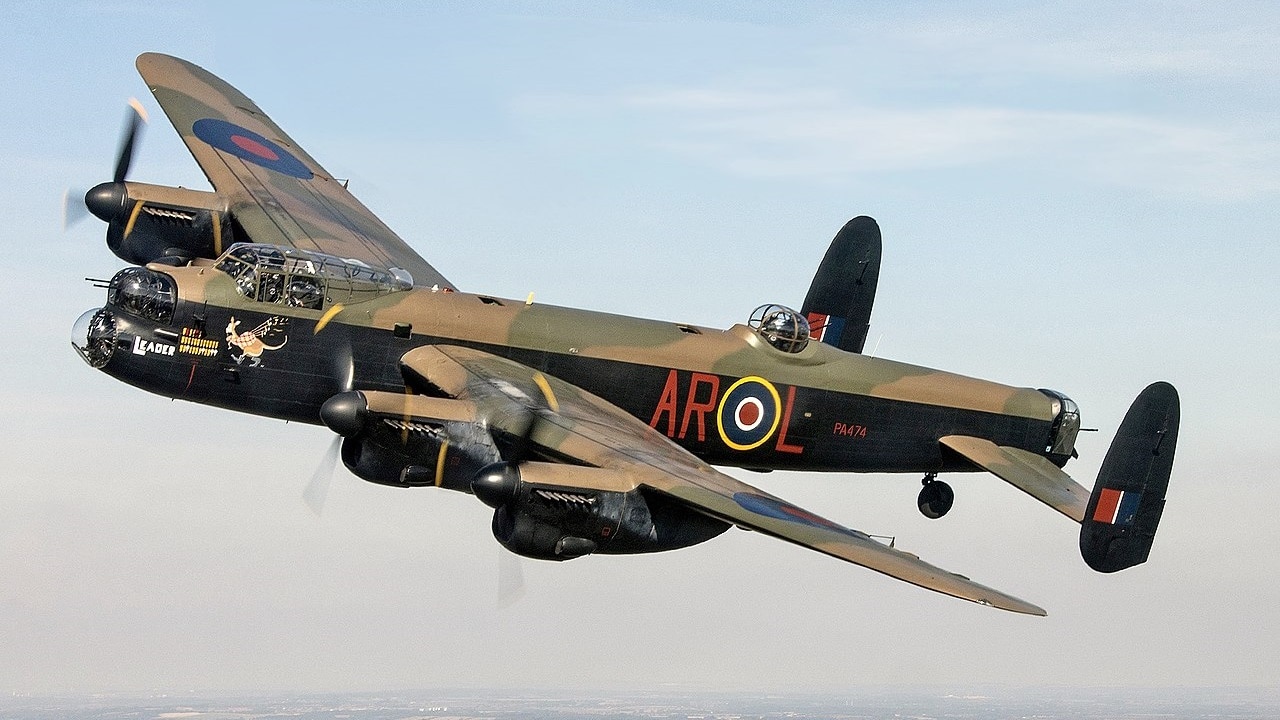In history’s retellings of WWII air battles, RAF Bomber Command’s heavy bombers may seem overlooked in movies, fiction and non-fiction books when compared to their U.S. Airmy Air Forces (USAAF) counterparts. The U.S. bombers such as the B-17 Flying Fortress, B-24 Liberator, and B-29 Superfortress appear to get all the attention. This in no way diminishes the accomplishments and sacrifices alike of the British bombers and their crews. Without a doubt, the two mainstays of RAF Bomber Command during that earth-shattering conflict were the Avro Lancaster and the Handley Page Halifax.
Avro Lancaster History and Specifications
Of the two British heavy bombers, the Avro Lancaster is arguably the more famous of the two; indeed, the BAE Systems info page goes so far as to call the warbird “The most iconic heavy bomber of World War II.” She made her maiden flight on 9 January 1941 and was officially introduced into operational service with the RAF in February 1942; the plane would also be adopted by the Royal Canadian Air Force (RCAF) and Royal Australian Air Force (RAAF), as well as seven other nations. The plane was built by Avro Aircraft AKA A.V. Roe & Company, named for founder Sir Edwin Alliott Verdon Roe.
On March 2, 1942, barely a month after entering RAF service, the Lancaster performed her first real-world operational mission, dropping naval mines in the vicinity of (IVO) the North Sea bay of Heligoland Bight, and eight days later conducted her first true bombing mission, over the German city of Essen, North Rhine-Westphalia.
As also noted by the BAE Systems page, “Although the Avro Lancaster was primarily a night bomber, it excelled in many other roles including daylight and precision bombing raids. In the latter role, some were adapted to carry the 12,000 lb Tallboy and ultimately, the 22,000 lb Grand Slam Earthquake bombs.”
Specifications included a fuselage length of 69 feet 4 inches, a wingspan of 102 feet, an empty weight of 36,457 pounds, a maximum takeoff weight of 68,000 lbs, and a max airspeed of 282 mph (246 knots); Armament consisted of two .303 caliber (7.7mm) Browning Mk II machine guns in the nose turret, two more such guns in the upper turret, and four of them in the rear turret, along with a maximum normal bomb load (not counting the Tallboy and Grand Slam versions) of 14,000 lbs.
Handley Page Halifax History and Specifications
The Handley Page Halifax, though less “iconic” than the Lancaster, actually predated her Avro counterpart, making her maiden flight on October 25, 1939, and entering into official RAF operational service on November 13, 1940. The warplane was manufactured by Handley Page Limited, named for founder Sir Frederick Handley Page.
The Halifax ended up flying 75,532 bombing sorties during WWII and accounted for over 25 percent of the bombs dropped on Germany by the RAF.
As noted by military aviation historian Guy Davey in an article for PlaneHistoria, “One of the most notable operations to feature the Halifax took place on the 24th of July, 1941 when No. 35 and No. 76 squadrons of the RAF flew to the port of Brest in Northern France to bomb the German battleship, Scharnhorst … Although the Scharnhorst was not sunk during the attack, it sustained heavy damage and had to be moved to a safer location as a result.”
Specifications included a fuselage length of 71 feet 7 inches, a wingspan of 104 feet 2 inches, a height of 20 feet 9 inches, an empty weight of 38,870 lbs, a maximum takeoff weight of 65,000 lbs, and a max airspeed of 282 mph (245 knots). Armament was eight Browning .303 machine guns, one .303 Vickers K machine gun, and 13,000 lbs. of bombs.
Where Are They Now?
Out of 7,377 Avro Lancasters built, 17 survive today, two of which are airworthy: tail number PA474, which is operated by the Battle of Britain Memorial Flight out of Coningsby in Lincolnshire, England; the other is FM213, affectionately nicknamed “Vera,” operated by the Canadian Warplane Heritage Museum in Mount Hope, Hamilton, Ontario. As for the 15 static displays, I can personally vouch for R5868 AKA “S-for-Sugar” at the RAF Museum in the Hendon section of London; she is quite an impressive sight to behold up close and personal.
In turn, 6,176 Handley Page Halifaxes were built, with the Pakistani Air Force being the last to retire the venerable warbird, doing so in 1961. Alas, only three survive intact today, none of them airworthy: NA337 at the National Air Force Museum of Canada in Trenton, Ontario; HR792 at the Yorkshire Air Museum in Elvington, North Yorkshire, England; and W1048 at RAF Museum London.
Christian D. Orr is a former Air Force Security Forces officer, Federal law enforcement officer, and private military contractor (with assignments worked in Iraq, the United Arab Emirates, Kosovo, Japan, Germany, and the Pentagon). Chris holds a B.A. in International Relations from the University of Southern California (USC) and an M.A. in Intelligence Studies (concentration in Terrorism Studies) from American Military University (AMU). He has also been published in The Daily Torch and The Journal of Intelligence and Cyber Security. Last but not least, he is a Companion of the Order of the Naval Order of the United States (NOUS).

